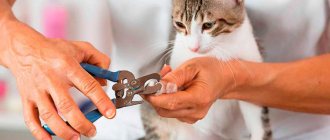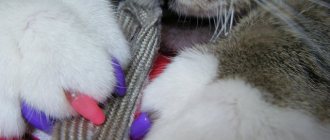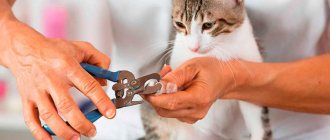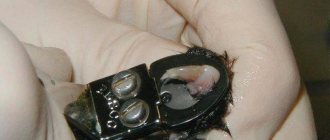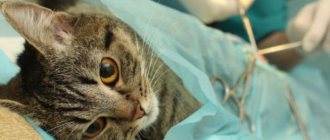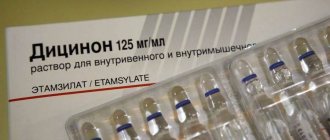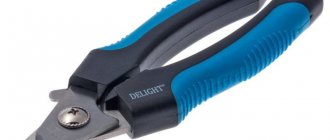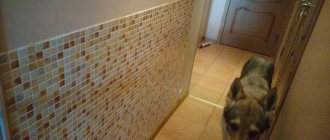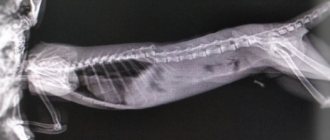Save the article:
Evolution has changed the appearance of cats, but has left such an important tool as claws unchanged. Cats can sort things out with rivals with the help of sharp claws, as well as get food and help take a high, impregnable fortress. This is all understandable if the cat is wild and a threat to the streets. But in domestic cats, declawing is a fairly common procedure.
Often, a pet’s claws are removed due to problems associated with the kitten growing up: no one likes damage to property, and even if the cat is particularly grumpy, the owners themselves may suffer.
The surgical procedure that makes a cat's paws “soft” is called onychectomy. During the operation, the entire claw phalanx is removed. In addition to cats, onychectomy is performed on dogs, primates and, if necessary, birds. Declawing is generally carried out according to indications and always under general anesthesia.
At what age can a cat be declawed?
Owners who are thinking about having a cat declawing operation are concerned about the question of when they can start the procedure. But before taking such extreme measures for cats who have the opportunity to walk, take into account that the animal will remain defenseless.
A kitten should not have its claws removed: their soft scratches do not cause harm; the body continues to form. In addition, it is absolutely cruel to subject a child to such stress.
According to the veterinarian’s recommendations, declawing surgery is performed on a kitten no earlier than 6-7 months. But it would be better to do it within a period of eight months to a year: the cardiovascular system has already become stronger, and the cat will have to get used to the consequences of walking without claws and adapt again in life situations. Therefore, if the owner has already decided to take such measures, then there is no need to delay and wait - in the absence of serious medical contraindications, the operation is easier to tolerate at a young age.
Cost of the “soft paws” procedure
The price is affected by the level of services and location of the medical institution. Moscow clinics ask for 2-5 thousand rubles. for such an operation. In remote centers the cost is reduced to 1 thousand. Due to the complexity of the operation, it is worth choosing a specialized clinic, or better yet, where the doctor comes to the cat’s home. Such a call will cost more, but the pet will recover faster.
Another reason for contacting a specialized institution is the reliability and honesty of the staff. Now that few people undertake onychectomy, there are many advertisements with false promises.
For unfortunate surgeons, the main thing is money, not caring for the animal. Often operations based on such advertisements are carried out without following the correct technology and in violation of sterility. Such assistance, when inflammation begins, sometimes ends in amputation of the paw.
A cat's claws are vital
Advantages and disadvantages of declawing cats
global $ads_google;
//data-ad-slot=”2475549904″ $ads_google = empty($ads_google) ? false : true; ?> if ($ads_google == false) {?> $ads_google = true; ?> } ?> It doesn't take long to remove a cat's claws. But are there any advantages from this? Yes, I have. This is the impossibility of damaging furniture and the absence of scratches on the skin of household members.
But the disadvantages include a number of points:
- anesthesia is not just a dream, but stress for the body;
- the animal is in great pain for a very long time after the operation. The pain is dulled with various painkillers, which is also considered an intervention in the body;
- the phalanx may grow back and require repeated surgery;
- This is real stress for a cat, which not every animal experiences without consequences.
- a cat without claws is defenseless, and any trip outside can end in disaster;
- as a result of onychectomy and a feeling of vulnerability, the pet may use its teeth;
- the pet’s character changes, it may become withdrawn;
- Difficulties with the toilet: sometimes cats refuse to go to the litter box due to the inability to rake;
- the animal will never step on the entire foot completely again in its life, which affects its gait.
Therefore, maybe it’s worth thinking about other options for protecting furniture from cat scratches?
Consequences, risks and complications
The psychological consequences can be unpredictable: adapting to a new lifestyle and experiencing severe stress, the animal can become irritable, withdrawn, and aggressive. Having lost a vital organ, a pet may perceive this as a danger and begin to avoid people. The situation is fraught with problems with going to the litter box: the cat may lose interest in the box due to the inability to “bury” the filler.
Possible physical effects, risks and complications include:
– prolonged and severe pain, inability and discomfort;
– deterioration of condition after anesthesia;
– violation of coordination and functions of the vestibular apparatus: the center of gravity shifts to the entire paw;
– osteomyelitis: inflammatory infectious disease of the bones;
– curvature of the spine, joint diseases;
– risk of developing an inflammatory infectious process;
Description of declawing surgery
Onychectomy is banned in a number of European countries.
Local anesthesia is sometimes used for the operation, but general anesthesia is more often used.
The claws are removed entirely from the first phalanx of the finger. A suture and anesthetic ointment are applied to the damaged area. Then the paw is bandaged, and a collar is put on the cat’s neck, which will protect the seams from licking.
Along with the application of anesthetic ointment, auxiliary injections are administered.
Reviews
Statisticians conducted a survey of owners of animals that had their claws removed. The result showed: 76% of people regret doing this and 24% responded positively that the cat walks without claws. Veterinarians, 100%, are against onychectomy:
- If the operation is carried out only on the basis of the owner’s wishes, they consider it a mockery of the animal, comparing it with the amputation of a person’s fingers;
- frequent serious consequences - unjustified risk;
- Many veterinary surgeons, unless there is a medical indication, do not agree to perform such an operation.
Consequences of deletion
After the operation, the following consequences may appear:
- soft tissues after such an injury on the paws become inflamed, which is fraught with the onset of a necrotic process;
- Losing a large amount of blood during the declawing procedure complicates the healing process;
- impaired coordination of movements;
- difficulties associated with recovery from anesthesia.
Before the operation, consult a doctor at the clinic and identify the presence of serious medical indications: sometimes the cat actually needs to have 1-2 claws removed. In any case, first assess all the risks, and then begin the procedure.
Legality
Cosmetic veterinary surgery is popular in the United States - animals have ligaments cut, piercings, and implants inserted. But even in their historical homeland, the “Soft Paws” procedure is abandoned due to the negative impact on health and quality of life. Declawing without indication has already been banned in 12 states.
In European countries, onychectomy without medical indications has long been prohibited; it is considered intentional mutilation. This is not a subjective attitude, but a legal definition of the essence of the process. A complete ban applies in the following countries:
- Great Britain
- Netherlands
- Germany
- Denmark
- Sweden
- Finland
- Norway
- Australia
- Israel
- Brazil
- Portugal
- Czech
- Serbia
- Belgium
- France
- Italy
- Spain
- Ireland
In Russia, a project to ban euthanasia, cupping and onychectomy without indications is under development. It will complement the already adopted Responsible Animal Welfare Act. Many breeders stipulate a ban on the removal of phalanges in the sales contract, but it is difficult to track its implementation. About a third of Russian clinics do not provide this service.
Rehabilitation of cats after onychectomy
When the cat's claws are removed, the process of recovery after surgery begins, both for the condition of the paws and for the entire body. Fluffy needs the caring attitude of the owner.
There are a number of nuances for caring for a cat:
- pain relief in the form of injections, if necessary;
- daily treatment of wounds;
- the dressing needs to be changed regularly;
- A visit to the doctor is recommended once a week
.
The cat is really looking forward to its owner's love and care, only in this case it will get better sooner.
The recovery period after surgery lasts a month. During the first few days it is painful for the cat to stand on its paws; it will be hampered by pain and discomfort. Then the walking process gradually improves, but the cat may limp.
It is better to remove the cat's claws first on the front paws and then on the back paws. One by one deletion is allowed. This requires expert advice.
Alternatives to surgery
Onychectomy is a radical method. You can solve the problem of furniture damage in other ways that have a temporary effect:
- nail trimming (can be done independently or in veterinary clinics);
- the use of anti-scratch pads - silicone overlays on the claws, which are attached using special glue (they need to be changed monthly);
Silicone claw covers need to be changed once a month.
- training to use a scratching post;
A cat can be trained to sharpen its claws in only one place
- the use of repellent sprays (they contain natural ingredients that are safe for animals);
- purchasing toys that will distract your cat from scratching furniture.
Video: how to avoid damage to furniture by cats
Cost of declawing
global $ads_google;
//data-ad-slot=”2475549904″ $ads_google = empty($ads_google) ? false : true; ?> if ($ads_google == false) {?> $ads_google = true; ?> } ?> If we take into account the price of declawing a cat within the central district of Russia, then the total cost can range from 1,500 to 5,000 rubles. The status of the clinic, the skill of the doctor, and the distance from the city center play a role.
There are veterinarians who specialize in surgery, and they should be given preference.
If you call a doctor to remove a cat’s claws at home, the price will not increase much, and healing will be faster.
What is “onychaetcomia”?
Onychectomy or soft paw surgery is an increasingly popular procedure, along with sterilization, as an alternative to conventional nail trimming for cats.
During onychectomy, the animal is completely deprived of its claws.
This surgery is performed by a veterinarian under general anesthesia. The doctor amputates the end whole phalanx of the fingers along with the claws. The procedure can be carried out through:
– removal of the nail plate with a scalpel and scissors;
– declawing using laser surgery;
The procedure is carried out under the supervision of a specialist
The operation is performed in a clinic, but there is also a home visit. In order to minimize pain, the animal is injected with an anesthetic, and additional medication may be given orally. The rehabilitation period can take a week and during this time the animal needs careful care.
Postoperative care
After the operation, the animal is put on a collar, which will help avoid licking the stitches.
Typically, recovery after surgery takes about 1 month. During this period, pet owners will need to clean the stitches every day with an antiseptic solution prescribed by a veterinarian. The cat needs to be put on a special collar, which is attached to the neck and prevents it from licking the seams. The animal will need to wear a collar until they are removed. Mostly, stitches are removed 2 weeks after the “soft paws” operation.
To reduce the likelihood of infection in the body, the veterinarian prescribes antibacterial medications. It is not recommended to use regular toilet filler. Veterinary doctors from the Zoovet clinic advise placing torn paper in the tray. In addition, the owner will need to carefully care for the cat until it adapts to new living conditions. Care and attention and playing with your pet will help reduce stress from the procedure.
